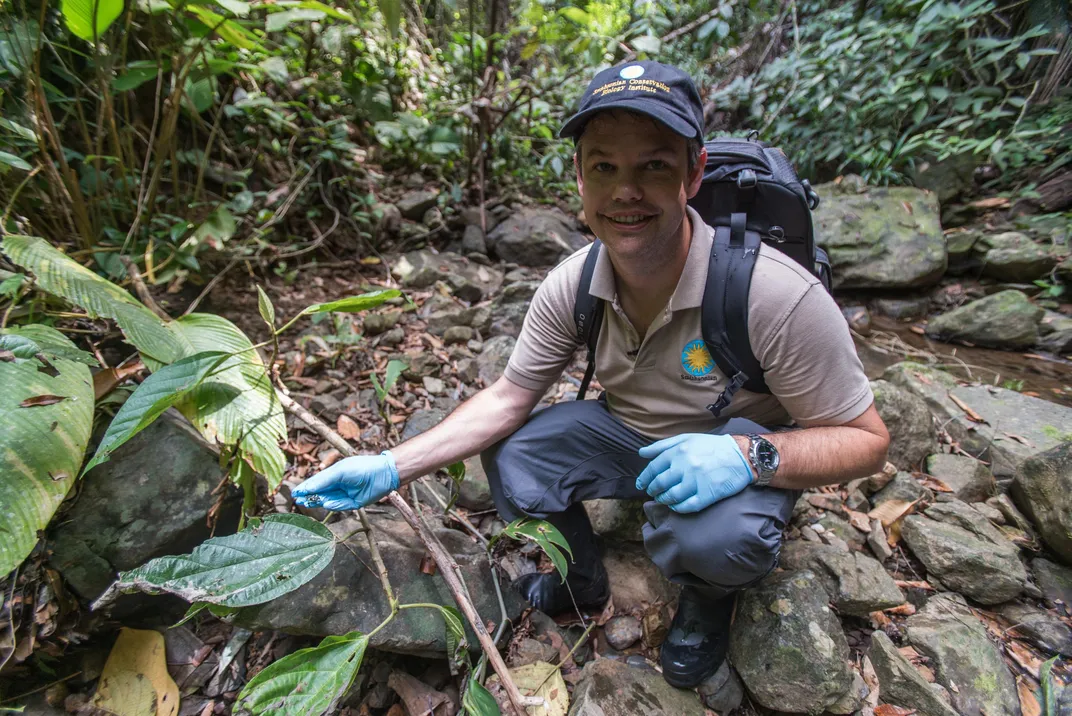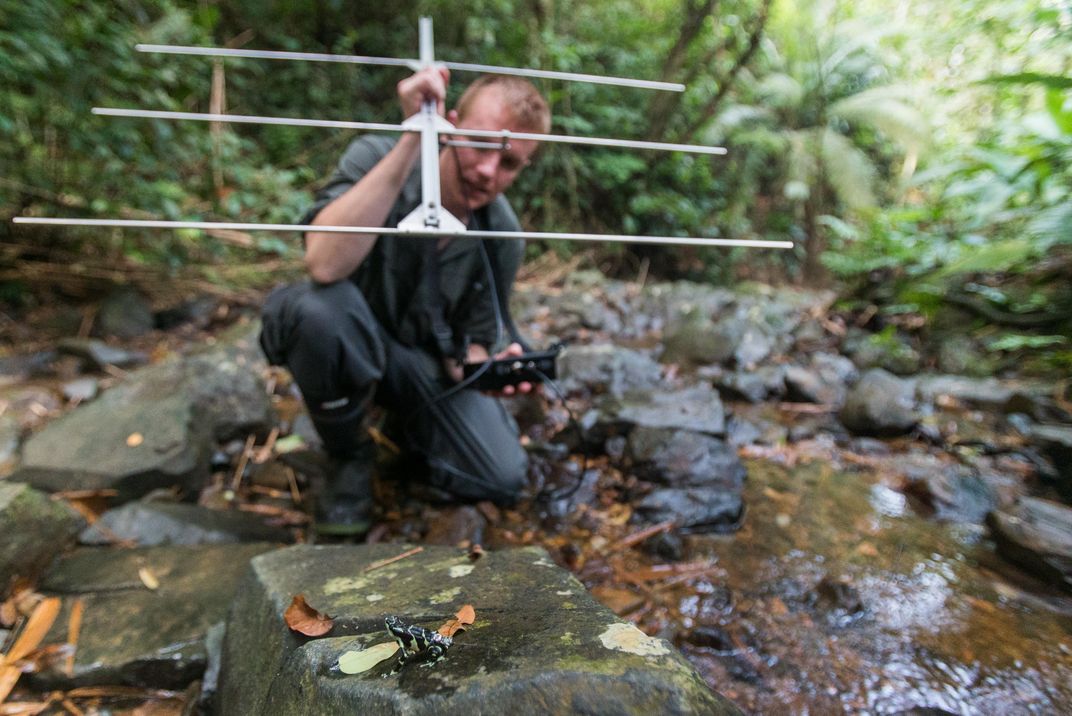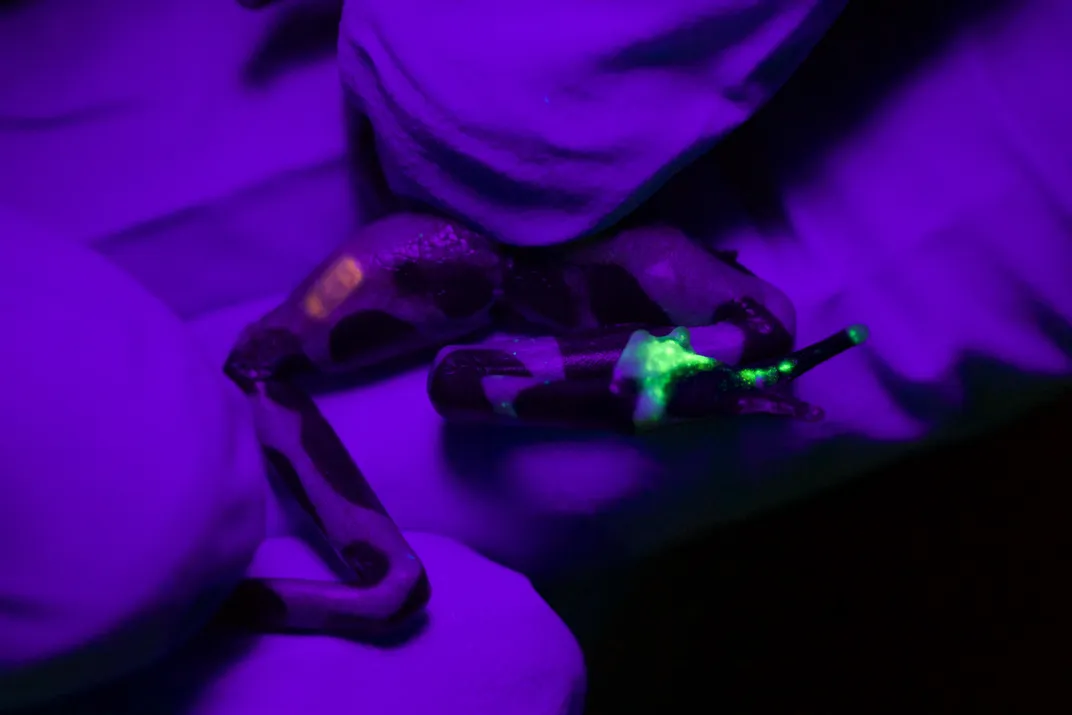A Pioneering Force of Harlequin Frogs Set Out to Help Save Their Species
Outfitted with tiny transmitters, these frogs are released to face the challenging chytrid fungus that decimated their populations
A green and black frog crawls up a steep rock. Though a collection of drab electronic circuits is secured around his waist by a thin cotton belt, the amphibian handles the ascent with easy agility. This Limosa harlequin frog is part of an experiment to find out if captive-bred endangered frogs can be successfully released into the wild and tracked with radio transmitters.
Amphibians all around the world are rapidly disappearing because of the deadly chytrid fungus. Infected animals slow down, stop eating and frequently die. Zoos and aquariums have stepped in to preserve many of these endangered species by maintaining them in captivity. Between 2008 and 2010, as chytrid was killing off the amphibians, the Panama Amphibian Rescue and Conservation Project rescued a population of breeding animals and held them captive for their own safety. But the researchers want to know if those animals that were reared for generations in captivity will ever be able to go back into the wild.
Researchers from Smithsonian's Conservation Biology Institute (SCBI) and the Smithsonian Tropical Research Institute are trying to answer that question by releasing 90 Limosa harlequin frogs into their native habitat, the Mamoní Valley Preserve in Panama and tracking them with tiny radio transmitters.
Sixty of the frogs were given "soft releases," which involved being kept in cages in the field for a month before release. This allowed them to acclimate to wild conditions and feed on invertebrates while being protected from predators. Another 30 frogs were released to set out as pioneers into the wild without an acclimatization period. Researchers will compare the relative success of each group to find out whether one method works better than the other.
“Our primary question for this study is how can we transition frogs from captivity to a wild situation in a way that is going to maximize the chances that these frogs are going to survive,” says Brian Gratwicke, a conservation biologist at SCBI and international program coordinator for the Panama Amphibian Rescue and Conservation Project. “So if they were to all get eaten in one day by a hungry snake, or a raccoon, or something, then we would need to be able to study the effects of disease in these animals.”
Sixteen of the frogs (eight from each group) have been outfitted with radio transmitters weighing only a third of a gram. While radio collar studies on larger animals have been state-of-the-art for decades, this kind of ultra-small technology for tracking frogs did not exist until relatively recently. In any collar study, important consideration has to be given to how the tracking apparatus may interfere with the animal's movement and ability to evade predators. Smithsonian scientists initially tested the devices on frogs in captivity before deploying them in this first field test.
The least disruptive place to attach the tracking device was around the waists of the frogs, like a utility belt. The belt is made of thin cotton cord that will naturally fall apart after about a month, ensuring that the frogs aren't stuck wearing these devices long after the batteries have died. To prevent the string from cutting into the frogs' skin, the researchers ran it through a section of soft plastic tubing. The result doesn't seem to interfere with the frogs' lives at all.
“One of our colleagues who was working on this has photos of two frogs [of a different species] mating with the transmitters on,” Gratwicke says. “These harlequin frogs are easy to put transmitters on because their skin is not slippery. . . so far none of the transmitters have come off.”
Gratwicke says that maintaining a species like this in captivity requires between 200 and 300 adult animals that are evenly represented from about ten original pairs. They only need to keep up to 20 eggs from any one clutch for the breeding program. With limited space to raise tadpoles and frogs, they can't risk being overwhelmed and don't want the population to become overly skewed towards one genetic sub-group.
“We had a single clutch of eggs that we reared for this experiment,” Gratwicke says. “Five hundred and thirty of them. That means that clutch is over-represented in captivity.”
This was how Smithsonian was able to risk experimentally releasing 90 frogs from the captive adult breeding population of only 220. They allowed far more eggs than usual to hatch from a single clutch.
Eventually, the fungus is expected to kill off the descendants of the released frogs. But there is hope for the long run.
“One of the ideas out there is that when the epidemic came through, there was so much of the fungus that built up from so many frogs dying that it was detrimental,” Gratwicke says. “But after chytrid is endemic for a while, those rates kind of drop and stabilize and perhaps it might be a situation where frogs can become infected and then clear an infection.”
Gratwicke and his team have found that the frogs tend to stay right in the immediate area where they were released. Even the 74 frogs without transmitters have been relatively easy to keep track of and locate. Mostly.
“So far we've only had one frog that has been eaten,” Gratwicke says. “We're not sure what ate it. Our guy in the field found a guilty-looking scorpion next to the frog's carcass.”
/https://tf-cmsv2-smithsonianmag-media.s3.amazonaws.com/accounts/headshot/JacksonLanders.jpg)
/https://tf-cmsv2-smithsonianmag-media.s3.amazonaws.com/filer/0f/16/0f16191d-e4ef-4bc4-b3bd-02dbeaea7263/33990072143_c.jpg)
/https://tf-cmsv2-smithsonianmag-media.s3.amazonaws.com/filer/8e/f8/8ef8eae1-3296-42a3-b348-74b0ad6d3312/dsc00400.jpg)




/https://tf-cmsv2-smithsonianmag-media.s3.amazonaws.com/accounts/headshot/JacksonLanders.jpg)